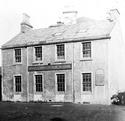 This period witnessed the beginnings of a rapid expansion in the provision of schools that was to accelerate during the Victorian era. It also set the 19th century trend of schools being provided by a very wide range of individuals and organisations including the Town Council, religious organisations and charities. The most important school was the Old Grammar School run by the Town Council that in 1788 moved from Greyfriar's Wynd to a new building near George Square. The rector, however, refused to enter into the spirit of the times by expanding the rigid classical education to include more "commercial" subjects such as Mathematics and Geography. The Town Council replied by abolishing the post of rector and its four masters, Bald, Dow, Braidfoot and Barr ran the school. In 1834, the school, renamed the High School, was re-housed in a new building next to the 1788 site.
This period witnessed the beginnings of a rapid expansion in the provision of schools that was to accelerate during the Victorian era. It also set the 19th century trend of schools being provided by a very wide range of individuals and organisations including the Town Council, religious organisations and charities. The most important school was the Old Grammar School run by the Town Council that in 1788 moved from Greyfriar's Wynd to a new building near George Square. The rector, however, refused to enter into the spirit of the times by expanding the rigid classical education to include more "commercial" subjects such as Mathematics and Geography. The Town Council replied by abolishing the post of rector and its four masters, Bald, Dow, Braidfoot and Barr ran the school. In 1834, the school, renamed the High School, was re-housed in a new building next to the 1788 site.
 By the 1830s there were approximately 144 other schools in the city educating nearly 17,000 pupils. Some were taught free of charge in charity schools, but most had to pay a small fee. Day schools were supplemented by Sunday Schools run by the church and providing the only means of schooling for many children. In any case very few children were educated beyond today's equivalent of Primary School.
By the 1830s there were approximately 144 other schools in the city educating nearly 17,000 pupils. Some were taught free of charge in charity schools, but most had to pay a small fee. Day schools were supplemented by Sunday Schools run by the church and providing the only means of schooling for many children. In any case very few children were educated beyond today's equivalent of Primary School.
 In 1827, Glasgow made a contribution to school education for which the city became world famous. David Stow opened the Glasgow Model School that combined teacher training and a day school in the one institution. Stow's influence has carried on into the 21st century and his name is remembered in Stow College and the David Stow Building in the Faculty of Education at the University of Strathclyde.
In 1827, Glasgow made a contribution to school education for which the city became world famous. David Stow opened the Glasgow Model School that combined teacher training and a day school in the one institution. Stow's influence has carried on into the 21st century and his name is remembered in Stow College and the David Stow Building in the Faculty of Education at the University of Strathclyde.